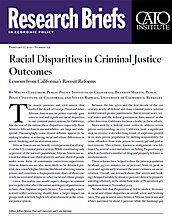African Americans are heavily overrepresented at all stages of the U.S. criminal justice system. While constituting only 13 percent of the nation’s population, African Americans account for almost one-third of arrests and one-third of people under some form of community corrections supervision. African Americans are also more likely to be detained pretrial, face a much higher lifetime likelihood of serving time in prison, and constitute a disproportionate share of those currently incarcerated relative to other racial and ethnic groups.
Given this reality, one would expect changes in criminal justice policy that affect the nature and degree of punitiveness to have clear disparate impacts by race. For example, a move toward stiffer sentencing should have a larger impact on groups with relatively high levels of involvement in the criminal justice system.
Between the late 1970s and the first decade of the 21st century, nearly all federal and state criminal justice reforms tended toward greater punitiveness. But in recent years, several states and the federal government have moved in the other direction. California has been a leader in these efforts.
Motivated by a federal court order to address severe prison overcrowding, in 2011 California took a significant step to reverse a decades-long trend of explosive growth in its state prison population by shifting responsibility for some offenders from state prison to county jail and probation systems. This reform—known as realignment—was followed by several voter initiatives, including Proposition 47, which reclassified a number of drug and property felonies as misdemeanors.
These reforms have helped reduce the prison population by about 44,000 inmates (or 25 percent) from its peak in 2006 and significantly lessened the state’s reliance on incarceration. Overall, our research shows that arrests and bookings dropped notably, by about 10 percent (driven by property and drug offenses), in the immediate wake of Proposition 47’s implementation in November 2014.
We also find that Proposition 47 led to modest decreases in racial and ethnic disparities in overall arrest and booking rates. The gap in arrest rates between African Americans and whites narrowed by about 6 percent, while the bookings gap shrank by about 8 percent. Proposition 47 did not meaningfully change the disparities in arrest and booking rates between Latinos and whites, which are only a small fraction of the disparities between African Americans and whites.
Racial disparities narrowed much more for the offenses targeted by the reform. The gap between African Americans and whites in arrest rates for property and drug offenses dropped by about 24 percent, and the bookings gap shrank by almost 33 percent. Even more striking, gaps between African Americans and whites in arrest and booking rates for drug felonies decreased by about 36 percent and 55 percent, respectively. We also find that the overall likelihood that an arrest leads to a jail booking dropped considerably, but it declined most among arrested whites. This is due largely to drug and property offenses making up a larger share of arrests for whites than for African Americans.
Finally, the cumulative impact of California’s reforms since 2011 has been a sizable reduction in the overall incarceration rate and a narrowing of racial disparities in the proportion of those incarcerated on any given day. In particular, the incarceration gap between African Americans and whites dropped from about 4.5 percentage points to 2.8 percentage points, a decrease of about 36 percent.
It is important to note that our arrest and bookings analysis is limited to the first few years of Proposition 47. While California’s prison and jail populations have not grown since, we do observe some increases in the likelihood of a booking in 2016. A closer look at our data shows that the increase is driven by, and limited to, misdemeanor property offenses. Nonetheless, our estimates represent average impacts over a two-year period, and more study is needed to discern longer-term effects.
What are lessons for other states? California’s drug and property offense classifications and felony thresholds before Proposition 47 were comparable to those of many states today. This suggests that similar reforms are possible elsewhere—and that such efforts could reduce the vast racial and ethnic differences in criminal justice experiences. While California was the first state to reclassify most drug possession offenses from felonies to misdemeanors, since then four other states have followed suit (Utah, Connecticut, Alaska, and Oklahoma). In addition, other states (including New York, Michigan, Connecticut, Mississippi, and South Carolina) have reduced their prison populations significantly over the past decade.
California’s reforms have provided useful opportunities for quasi-experimental research and criminal justice policy evaluations. Our analysis indicates strong evidence of meaningful decreases in racial disparities across key criminal justice outcomes following some of these reforms and suggests similar efforts could be undertaken in other states.
NOTE:
This research brief is based on Magnus Lofstrom, Brandon Martin, and Steven Raphael, “Effect of Sentencing Reform on Racial and Ethnic Disparities in Involvement with the Criminal Justice System: The Case of California’s Proposition 47,” Criminology and Public Policy 19, no. 4 (November 2020): 1165–1207, https://doi.org/10.1111/1745–9133.12527.

